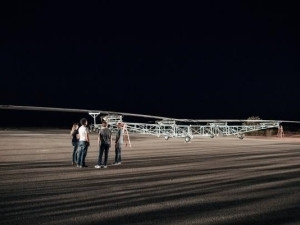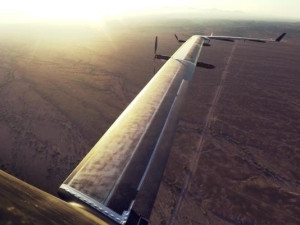Facebook, the world's largest social network, has reported the first test flight of its Aquila unmanned high-altitude, long-endurance solar airplane was successful.
The drone was in the air for 96 minutes, more than triple the minimum planned time. While at cruise altitude, it consumed 2 000W of power. The flight took place in Yuma, Arizona in the US, and was the culmination of two years of work.
Facebook plans to eventually have a fleet of Aquila airplanes in the air for up to three months at a time. They will beam connectivity to regions over 95km in diameter, using laser communications and millimetre wave systems.
In a bid to "connect the world", Facebook has a dedicated Connectivity Lab that invests in and develops technologies that will bring affordable Internet connectivity to the most far-flung nooks and crannies of the globe.
Facebook already has at least one in every seven people globally on its platform, and to lay claim to the rest, those people need to have an Internet connection.
Rival tech giant Alphabet has similar plans through a series of connectivity projects. The latest, Project Loon, sends solar-powered balloons 5 000m into the air to deliver Internet access through radio frequency signals to antennae connected to buildings on the ground.

Facebook has flown a fifth-scale version of Aquila for several months, but this was the first flight of the full-scale aircraft.
However, Jay Parikh, Facebook global head of engineering and infrastructure, says: "As encouraging as the first successful flight is, there is still plenty of work to be done."
In the coming months and years, the company will push Aquila to the limits in a lengthy series of tests. This test flight was designed to verify the operational models and overall aircraft design, says Parikh.
Facebook engineers Martin Luis Gomez and Andrew Cox said the first full-scale, low-altitude test provided Facebook's aeronautics team with data on numerous aspects of Aquila's performance: "Including the autopilot, motors, batteries, radios, ground station, displays, basic aerodynamic handling, structural viability and crew training."

Aquila has the wingspan of a Boeing 737. The craft weighs around 450kg ? the weight of a grand piano or a third as much as an electric car. It is made of a carbon fibre composite and half its mass is devoted to batteries.
Facebook CEO Mark Zuckerberg says the team will continue to make it lighter, as it "has to weigh as little as possible to stay up for as long as possible".
Its eventual altitude will be 18km and at that height the Aquila should only consume 5 000W of power. This is the same amount needed to power three hairdryers or a high-end microwave.
However, to reach this goal (and height), the social network's aeronautical team will need to break the world record for solar-powered unmanned flight, which currently stands at two weeks.
"It will also require Facebook to work closely with operators, governments and other partners to deploy these aircraft in the regions where they'll be most effective," says Parikh.

Gomez and Coz say: "Almost everything about Aquila ? from remaining airborne for months at a time, to transmitting wireless signal between other aircraft and the ground ? will require continued advances in science, engineering and design."
They detailed four challenges that have to be overcome.
The first is getting enough sun during daylight hours, especially during shorter days in winter.
The second is batteries and how much space they take up. "We're pushing the edge of high-energy-density batteries while exploring the best designs to ensure we have enough resilience in the system."
As the craft is so light and expansive, it flies at a much slower speed than current airplanes: 40kmph compared to 80kmph for a glider, or 320kmph for a commercial airliner.
The third challenge is not being able to rely on current aeronautical engineering thinking. "There is little to no precedent to guide us as we continue to optimise Aquila's performance."
The last challenge is getting it as cheap as possible to make. "For Aquila to succeed, it needs to be an economically viable alternative to current network infrastructure," say Gomez and Cox.
Video: https://www.facebook.com/zuck/videos/10102979862144171/
Share